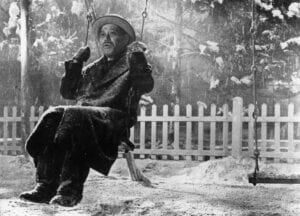
(This piece includes major spoilers for the film’s plot.)
Many urban planners, myself included, put Japanese planning on a pedestal of sorts. Japan is known for its urbanist achievements from efficient high-speed trains to delightful mixed-use neighborhoods of alleyways with tiny stores below compact residences (illegal to build in most of the United States, never forget!). So I was a little caught off guard by the opening sequence of Akira Kurosawa’s Ikiru (1952), in which a group of residents in postwar Tokyo attempting to turn an open sewer into a playground is shunted between government agencies who want nothing to do with their request. The main character, Kanji Watanabe, is among the indifferent bureaucrats, a detail I had known going in. But I had no idea that issues of urban planning were so crucial to the story, or at least important enough to leave me thinking, months after finishing the film, about what it means to plan in spite of it all.
By “it all,” I’m not just referring to the central conflict, which is that Watanabe is diagnosed with a terminal illness with months left to live (the phrase ikiru means “to live” or “living”). I’m speaking of the political environment that he inhabits—a caricature of callous, do-nothing government bureaucracy in which his subordinates, who gossip over who will become the next section chief when Watanabe dies, are paid comfortably to stamp approval or rejection upon piles of documents daily and do little else.
This is an environment in which, once Watanabe decides he wants to actually do something with his remaining days (in this case, champion the playground project), the status quo is clear. He must resort to hounding other agencies and politicians for any action—literally sitting in another official’s office until he relents in one scene. In other words, not capital “P” planning, but rather planning as it takes place in real life. Watanabe eventually sees the project completed and visits it in one of the film’s most poignant moments, but dies soon thereafter.
This is a society with cynical people, as exposed at Watanabe’s funeral. Colleagues and politicians blatantly diminish his role, claiming credit or labeling the project a product of circumstance and political expediency. His family members fail to understand his sudden passion for planning public works, speculating that he was simply invigorated by what they assumed was an affair with a young former colleague.
Only the group of parents who had lobbied for the playground show up to the funeral to mourn Watanabe and praise his work genuinely, putting the disrespect of the other attendees into sharp relief. Eventually, one idealistic subordinate does speak up to defend him, bringing the drunk crowd of former colleagues to resolve to follow in Watanabe’s footsteps and do something as well.
The film’s closing montage shows that they do not. Nothing systemic changes within the bureaucracy or in politics. That idealistic younger colleague looks over the completed playground in one of the final scenes, alone. Ikiru is not uplifting in the way that you might imagine a narrative about finding purpose before death should be. Instead, it is realistic, depicting what it looks like to plan for the public in a world that will largely ignore, dismiss, or co-opt those efforts.
With its realism, the film asks: does it matter if “planning” is more about outlasting resistance than doing good planning work? Is it worth it if only a few people appreciate your projects, while others claim credit or criticize you for trying? And can there be progress in a broken system even if the system remains broken?
As bleak as the story and its ending may seem, my reaction to these questions after finishing Ikiru was, without a doubt, “yes.” Sure, I might be biased by my thoughts on modern Japanese urbanism and my assumption of a decades-later happy ending for the movie’s city and society. But even if I cast that context aside, Watanabe’s work on the playground clearly matters to him and the public that he comes to serve in his last few months of life. He barely has a chance to enjoy the space himself, yet is clearly at peace in his final moments on screen—showing the fulfillment that such work in service of others, regardless of its scale or quantity, can bring. But it’s not just about personal fulfillment, of course. The playground tangibly benefits residents, and inspires at least one person to carry on the mantle of public service. “Yes,” the film argues: all of this matters even if (or maybe even because) the playground is the only thing of note that Watanabe accomplishes in his all-too-brief life.
Despite being over 70 years old, Ikiru can feel like a film set in today’s American cities, in which building infrastructure is an arduous process that requires unreasonable amounts of patience and political happenstance for any hope of success. It’s not uncommon for planners to work for a decade or more on a single project, so one might conceivably only see a handful get completed in their lifetime. I’m probably not alone in harboring doubts about what my future work will amount to, if anything, given this reality. For anyone facing this dilemma, Ikiru offers a hopeful yet believable perspective on what it means to work—and to live.
You can reach the author of this piece, Edwin Jeng, at ej737@nyu.edu
You can reach the editor of this piece, Calley Wang, at: csw9856@nyu.edu
Well spoken. Kuresawa’s philosophy rested on a condemnation of egotism and a constant exhortation to do things with others, and for others. And in a way, urban planning is based on the same premises: we work to create better cities for all. It does not matter how little we accomplish if we are guided by that principle.
Pietro Garau, urbanist
Rome, Italy